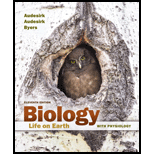
Taproots
- a. are characteristic of
dicots. - b. act as sugar sources when leaves are fully developed.
- c. are filled with sclerenchyma cells.
- d. include white potatoes.
Introduction:
The roots are the underground parts of the plant. The basic function is to absorb water and minerals and supply it to aerial parts of the plant. The roots also act as a storage unit for starch.
Answer to Problem 1MC
Correct answer:
The dicotyledonous plants exhibit the taproots. Therefore, option (a) is correct.
Option (a) is given as “are characteristic of dicots”.
Explanation of Solution
Justify reasons for the correct statement:
The major and first root emerged from the primary root system that grows in the downward direction is a taproot. This type of root is present in dicotyledonous plants. The secondary and tertiary roots emerge from the primary taproot that increases the absorption of water.
Hence, option (a) is correct.
Justify reasons for the incorrect statements:
Option (b) is given as “act as sugar sources when leaves are fully developed”.
The roots become sugar sources when the leaves are developing and emerging and this continues until then the leaves are capable of performing photosynthesis. Hence, it is a wrong answer.
Option (c) is given as “are filled with sclerenchyma cells”.
The sclerenchyma cells are dead cells that provide support to plant parts. The roots do not have sclerenchyma cells because they need to absorb water from soil. Hence, it is a wrong answer.
Option (d) is given as “include white potatoes”.
The potatoes are modified stems, whereas, the modified roots are sweet potatoes and carrots. Hence, it is a wrong answer.
Hence, options (b), (c), and (d) are incorrect.
The taproots are one of the characteristic features of the dicotyledonous plants.
Want to see more full solutions like this?
Chapter 44 Solutions
Biology: Life on Earth with Physiology (11th Edition)
Additional Science Textbook Solutions
Fundamentals Of Thermodynamics
Physics for Scientists and Engineers
Biological Science (6th Edition)
Chemistry
Campbell Biology in Focus (2nd Edition)
Genetics: From Genes to Genomes
- series of two-point crosses were carried out among six loci (a, b, c, d, e and f), producing the following recombination frequencies. According to the data below, the genes can be placed into how many different linkage groups? Loci a and b Percent Recombination 50 a and c 14 a and d 10 a and e 50 a and f 50 b and c 50 b and d 50 b and e 35 b and f 20 c and d 5 c and e 50 c and f 50 d and e 50 d and f 50 18 e and f Selected Answer: n6 Draw genetic maps for the linkage groups for the data in question #5. Please use the format given below to indicate the genetic distances. Z e.g. Linkage group 1=P____5 mu__Q____12 mu R 38 mu 5 Linkage group 2-X_____3 mu__Y_4 mu sanightarrow_forwardWhat settings would being able to isolate individual bacteria colonies from a mixed bacterial culture be useful?arrow_forwardCan I get a handwritten answer please. I'm having a hard time understanding this process. Thanksarrow_forward
- Biology How many grams of sucrose would you add to 100mL of water to make a 100 mL of 5% (w/v) sucrosesolution?arrow_forwardWhich marker does this DNA 5ʹ AATTGGCAATTGGCAATTGGCAATTGGCAATTGGCAATTGGCAATTGGC 3ʹ show?arrow_forwardThe Z value of LOD for two genes is 4, what does it mean for linkage and inheritance?arrow_forward
- Biology How will you make a 50-ul reaction mixture with 2uM primer DNA using 10 uM primer DNA stocksolution and water?arrow_forwardBiology You’re going to make 1% (w/v) agarose gel in 0.5XTBE buffer 100 ml. How much agarose are you goingto add to 100 ml of buffer? The volume of agaroseis negligible.arrow_forwardBiology How will you make a 50-ul reaction mixture with0.2 mM dNTP using 2-mM dNTP stock solution andwater?arrow_forward

 Biology (MindTap Course List)BiologyISBN:9781337392938Author:Eldra Solomon, Charles Martin, Diana W. Martin, Linda R. BergPublisher:Cengage Learning
Biology (MindTap Course List)BiologyISBN:9781337392938Author:Eldra Solomon, Charles Martin, Diana W. Martin, Linda R. BergPublisher:Cengage Learning Biology: The Unity and Diversity of Life (MindTap...BiologyISBN:9781305073951Author:Cecie Starr, Ralph Taggart, Christine Evers, Lisa StarrPublisher:Cengage Learning
Biology: The Unity and Diversity of Life (MindTap...BiologyISBN:9781305073951Author:Cecie Starr, Ralph Taggart, Christine Evers, Lisa StarrPublisher:Cengage Learning Concepts of BiologyBiologyISBN:9781938168116Author:Samantha Fowler, Rebecca Roush, James WisePublisher:OpenStax College
Concepts of BiologyBiologyISBN:9781938168116Author:Samantha Fowler, Rebecca Roush, James WisePublisher:OpenStax College Biology: The Dynamic Science (MindTap Course List)BiologyISBN:9781305389892Author:Peter J. Russell, Paul E. Hertz, Beverly McMillanPublisher:Cengage Learning
Biology: The Dynamic Science (MindTap Course List)BiologyISBN:9781305389892Author:Peter J. Russell, Paul E. Hertz, Beverly McMillanPublisher:Cengage Learning




